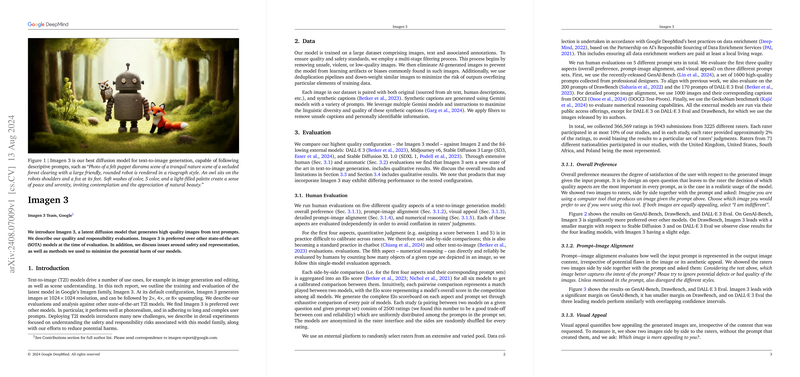Overview of the Paper "Imagen 3"
The paper "Imagen 3," authored by Google’s Imagen 3 Team, presents a sophisticated latent diffusion model for text-to-image (T2I) generation. Capturing the state-of-the-art, Imagen 3 is accentuated by detailed evaluations, robust safety measures, and practical insights into its deployment. The model is benchmarked against prominent competitors including DALL·E 3, Midjourney v6, and various versions of Stable Diffusion, consistently exhibiting superior performance in various aspects of image generation.
Key Contributions and Evaluations
The core contribution of "Imagen 3" lies in its capacity to generate high-resolution images ( pixels) that align accurately with extended and intricate text prompts. The evaluations in the paper span both human and automated assessments, focusing on several critical aspects:
- Human Evaluation: The model was assessed on five criteria, namely overall preference, prompt-image alignment, visual appeal, detailed prompt-image alignment, and numerical reasoning. Imagen 3 demonstrated noteworthy performance across these metrics. Specifically, the model topped overall preference surveys on extensive prompt sets such as GenAI-Bench, DrawBench, and DALL·E 3 Eval.
- Automated Evaluation: The paper employed metrics from contrastive dual encoders, VQA-based, and LVLM-based assessments to further gauge alignment and image quality. The validation highlighted VQAScore as the most reliable metric correlating well with human judgments, confirming Imagen 3’s leadership in prompt-to-image alignment.
Numerical Results and Benchmarking
Quantitative comparisons revealed that Imagen 3 not only exceeds its predecessor, Imagen 2, but also surpasses external competitors in critical areas. The model excelled in attributes such as detailed prompt adherence and counting accuracy, outperforming others by significant margins:
- Prompt-Image Alignment: The Elo rating for prompt-image alignment on benchmark datasets positioned Imagen 3 at an apex, underscoring its ability to faithfully render complex prompts into accurate visual representations.
- Visual Appeal: Although Midjourney v6 leads in sheer visual appeal, Imagen 3 maintains a close second, reflecting its balance between adherence to the prompt and aesthetic quality.
- Numerical Reasoning: Imagen 3 demonstrated a leading capability in numerical reasoning tasks on the GeckoNum benchmark, significantly outpacing models like DALL·E 3. This critical evaluation was measured by the model’s accuracy in generating images that reflect exact quantities as specified in prompts.
Theoretical and Practical Implications
The theoretical implications of Imagen 3 are largely tied to its advancements in image generation fidelity and prompt comprehension, setting new thresholds for future T2I models. On a practical level, the efficient handling of complex and lengthy text descriptions paves the way for applications in creative industries, professional design, and automated content creation.
Safety and Representation: Significant attention is dedicated to the responsible development of Imagen 3. Pre-training safety measures include comprehensive data filtering processes to exclude harmful content and deduplicating images to enhance dataset quality. Post-training interventions ensure privacy and mitigate risks such as overfitting and biased representations, with tools like SynthID watermarking being crucial in maintaining output integrity.
Future Directions and AI Developments
Given the advancements depicted in the paper, future research can envisage enhancements in areas where T2I models still face challenges. Noteworthy among these are tasks involving intricate spatial reasoning, complex language comprehension, and numerical consistency beyond the current threshold. These improvements are vital for application in more sophisticated domains requiring precise visual data interpretation.
Potential developments may also focus on ameliorating biases inherent in training datasets and refining safety protocols to preclude adversarial exploitation. As AI systems increasingly integrate into diverse sectors, ensuring equitable and robust outputs becomes imperative.
Conclusion
"Imagen 3" stands out as a confluence of innovation and meticulous evaluation in the field of text-to-image generation. By bolstering precision in conversion from text prompts to vivid and accurate images, and upholding stringent safety and fairness standards, the paper heralds substantial strides in T2I technology with implications that could revolutionize creative and professional fields. Researchers and practitioners alike should draw upon its evaluated strengths and acknowledged areas of improvement to propel further advancements in the AI domain.
